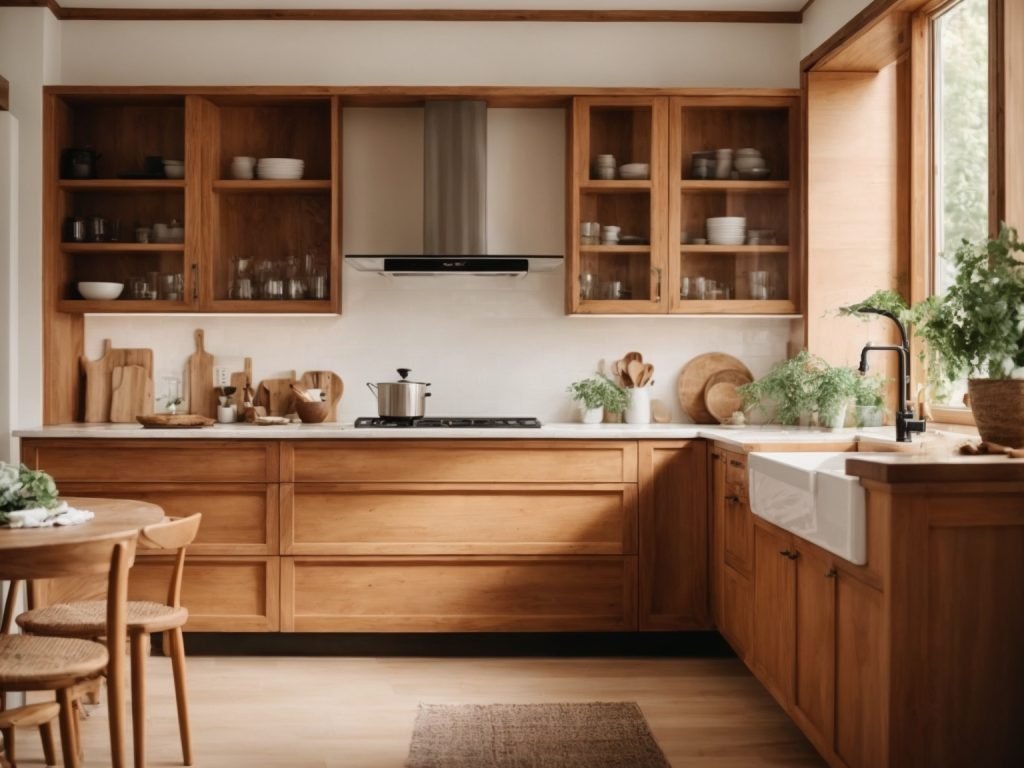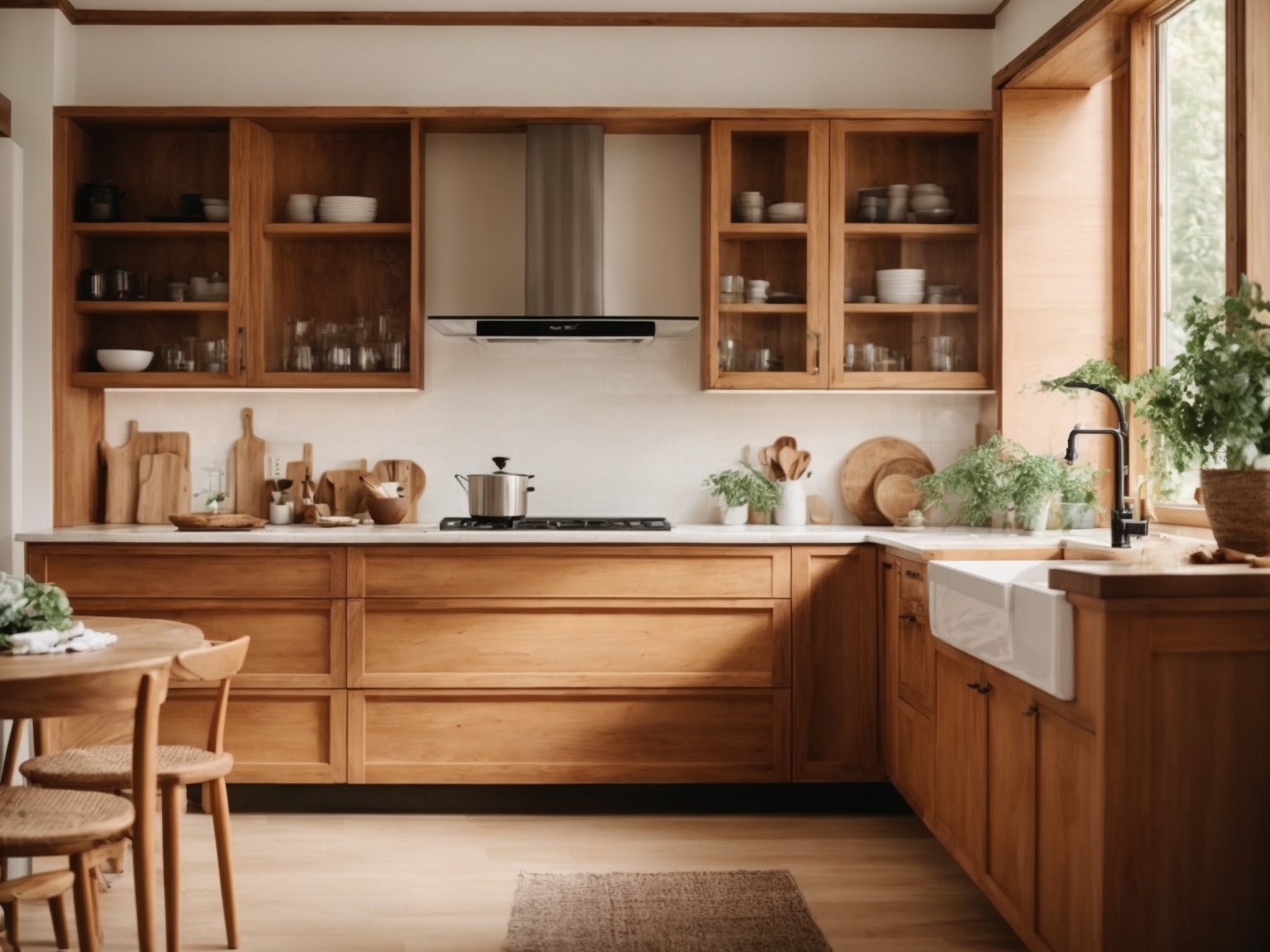Cleaning wooden cabinets can be a daunting task, but it’s an essential part of maintaining the look and quality of your kitchen. Over time, cabinets can accumulate dirt, grease, and grime, making them look dull and worn out. Fortunately, with the right tools and techniques, you can easily clean your wooden cabinets and restore their natural shine.
To start, it’s important to gather the necessary cleaning supplies. You’ll need a soft cloth or sponge, a mild soap or cleaning solution, and warm water. Avoid using harsh chemicals or abrasive materials that can damage the wood surface. Before you begin, remove any items from your cabinets and clear the surrounding area to prevent any spills or accidents.
Next, wipe down the cabinets with a damp cloth or sponge to remove any loose dirt or debris. Then, apply the cleaning solution to the cloth or sponge and gently scrub the cabinet surfaces, working in small sections. Be sure to rinse the cloth or sponge frequently and change the water as needed to avoid spreading dirt or grime. By following these simple steps, you can keep your wooden cabinets looking clean and polished for years to come.
Understanding the Basics of Wooden Cabinets

If you have wooden cabinets in your kitchen, it’s important to understand how to properly clean and maintain them. Wooden cabinets can add warmth and beauty to your kitchen, but they also require special care to keep them looking their best. In this section, we’ll cover the basics of wooden cabinets, including the types of wood commonly used and the cleaning challenges you may encounter.
Types of Wood
Wooden cabinets can be made from a variety of different woods, each with its own unique properties and characteristics. Some of the most common types of wood used for cabinets include:
- Oak: Oak is a popular choice for cabinets because it’s durable and has a distinctive grain pattern.
- Maple: Maple is a hard, dense wood that’s often used for cabinets because of its strength and durability.
- Cherry: Cherry is a beautiful, richly colored wood that’s often used for high-end cabinets.
- Birch: Birch is a light-colored wood that’s often used for cabinets because of its affordability and versatility.
When it comes to cleaning wooden cabinets, the type of wood you have will determine the best cleaning methods to use. Some woods are more sensitive to moisture than others, so it’s important to use the right cleaning products and techniques to avoid damaging your cabinets.
Common Cleaning Challenges
Wooden cabinets can be challenging to clean because they’re prone to collecting dust, grease, and grime. Here are some common cleaning challenges you may encounter when cleaning your wooden cabinets:
- Grease buildup: Over time, grease from cooking can build up on your cabinets, leaving them looking dull and dirty.
- Water damage: Wooden cabinets can be damaged by water if they’re not properly sealed or if they’re exposed to moisture for an extended period of time.
- Scratches and dents: Wooden cabinets can be easily scratched or dented, especially if they’re not properly cared for.
To keep your wooden cabinets looking their best, it’s important to clean them regularly and take steps to prevent damage. By using the right cleaning products and techniques, you can help ensure that your cabinets stay beautiful and functional for years to come.
Essential Cleaning Supplies
When it comes to cleaning your wooden cabinets, having the right supplies on hand can make all the difference. Here are some essential cleaning supplies you will need:
Natural Cleaning Agents
- White vinegar: This is an excellent natural cleaning agent that can effectively clean your wooden cabinets without damaging them. You can mix equal parts of white vinegar and water to create a cleaning solution.
- Lemon juice: Lemon juice is another natural cleaning agent that can help remove stains and grime from your wooden cabinets. You can mix lemon juice with water to create a cleaning solution.
- Baking soda: Baking soda is a natural abrasive that can help remove tough stains and grime from your wooden cabinets. You can mix baking soda with water to create a paste and use it to scrub your cabinets.
Commercial Cleaning Products
- Wood cleaner: A wood cleaner specifically formulated for cabinets can help keep your wooden cabinets looking clean and shiny. Look for a cleaner that is gentle and non-abrasive.
- Multi-purpose cleaner: A multi-purpose cleaner can be used to clean your wooden cabinets as well as other surfaces in your kitchen. Look for a cleaner that is safe for use on wood.
- Microfiber cloths: Microfiber cloths are great for cleaning wooden cabinets because they are gentle and won’t scratch the surface. They are also reusable and can be washed and used again.
Having these essential cleaning supplies on hand will make it easier for you to keep your wooden cabinets looking clean and shiny. Remember to always follow the manufacturer’s instructions when using commercial cleaning products.
Step-by-Step Cleaning Guide
Cleaning your wooden cabinets can be a daunting task, but with the right tools and techniques, you can have them looking brand new in no time. Follow these simple steps to clean your wooden cabinets effectively.
Dusting the Cabinets
Before you start cleaning your cabinets, it is essential to remove any dust or debris. Dusting your cabinets will prevent any damage to the wood and ensure that your cleaning solution works effectively. Use a soft cloth or a microfiber duster to remove any dust or debris from your cabinets. Be sure to get into all the nooks and crannies, including the corners and edges.
Applying the Cleaning Solution
Once you have dusted your cabinets, it’s time to apply the cleaning solution. You can use a mixture of warm water and mild dish soap or a wood cleaner diluted in warm water. Apply the solution to a soft cloth or a sponge, and gently rub it onto the surface of the cabinets. Be sure to cover all areas of the cabinets, including the doors, drawers, and shelves.
Wiping and Drying
After applying the cleaning solution, it’s time to wipe and dry your cabinets. Use a clean, dry cloth to wipe away any excess cleaning solution. Be sure to dry the cabinets thoroughly to prevent any water damage. You can also use a furniture polish or wax to give your cabinets a shine and protect the wood.
In conclusion, cleaning your wooden cabinets is a simple process that can be done with the right tools and techniques. By following these simple steps, you can have your cabinets looking brand new in no time.
Preventive Measures and Maintenance
Taking preventive measures and performing regular maintenance can help keep your wooden cabinets looking beautiful for years to come. Here are some tips to help you keep your cabinets in top shape.
Regular Dusting
Dust and dirt can accumulate on your cabinets over time, causing them to look dull and dirty. To prevent this, it’s important to dust your cabinets regularly. You can use a soft, dry cloth or a feather duster to remove dust and dirt from your cabinets. Be sure to dust the entire surface of the cabinet, including the corners and crevices.
Immediate Spill Cleaning
Spills can happen at any time, and if they’re not cleaned up immediately, they can cause damage to your wooden cabinets. To prevent this, it’s important to clean up spills as soon as they happen. Use a soft, damp cloth to wipe up spills, and be sure to dry the area thoroughly to prevent water damage.
Polishing and Conditioning
Polishing and conditioning your wooden cabinets can help keep them looking their best. There are a variety of products on the market that can help you do this, including furniture polish and conditioning oils. Be sure to choose a product that is safe for use on wooden surfaces, and follow the manufacturer’s instructions carefully.
By following these simple tips, you can help keep your wooden cabinets looking beautiful and in top condition for years to come. Regular maintenance and preventive measures are key to ensuring that your cabinets stay looking their best.
Dealing with Tough Stains
Wooden cabinets are a beautiful addition to any kitchen, but they can be difficult to clean, especially when it comes to tough stains. Here are some tips on how to deal with different types of tough stains.
Grease Stains
Grease stains are one of the most common types of stains on kitchen cabinets. To remove them, you will need a degreaser. Here’s how to do it:
- Mix one part white vinegar with one part water in a spray bottle.
- Spray the solution onto the stain and let it sit for a few minutes.
- Wipe the stain with a clean, damp cloth.
- Dry the area with a clean, dry cloth.
If the stain is particularly stubborn, you can try using baking soda. Mix baking soda with water to form a paste, apply it to the stain, and let it sit for a few minutes before wiping it away.
Water Stains
Water stains are another common problem when it comes to wooden cabinets. Here’s how to remove them:
- Mix one part white vinegar with one part water in a spray bottle.
- Spray the solution onto the stain and let it sit for a few minutes.
- Wipe the stain with a clean, damp cloth.
- Dry the area with a clean, dry cloth.
If the stain is particularly stubborn, you can try using toothpaste. Apply a small amount of toothpaste to the stain and rub it in with a soft cloth. Wipe the area clean with a damp cloth and dry with a clean, dry cloth.
Ink Stains
Ink stains can be difficult to remove from wooden cabinets. Here’s how to do it:
- Mix one part rubbing alcohol with one part water in a spray bottle.
- Spray the solution onto the stain and let it sit for a few minutes.
- Wipe the stain with a clean, damp cloth.
- Dry the area with a clean, dry cloth.
If the stain is particularly stubborn, you can try using a mixture of baking soda and water to form a paste. Apply the paste to the stain and let it sit for a few minutes before wiping it away with a damp cloth.
